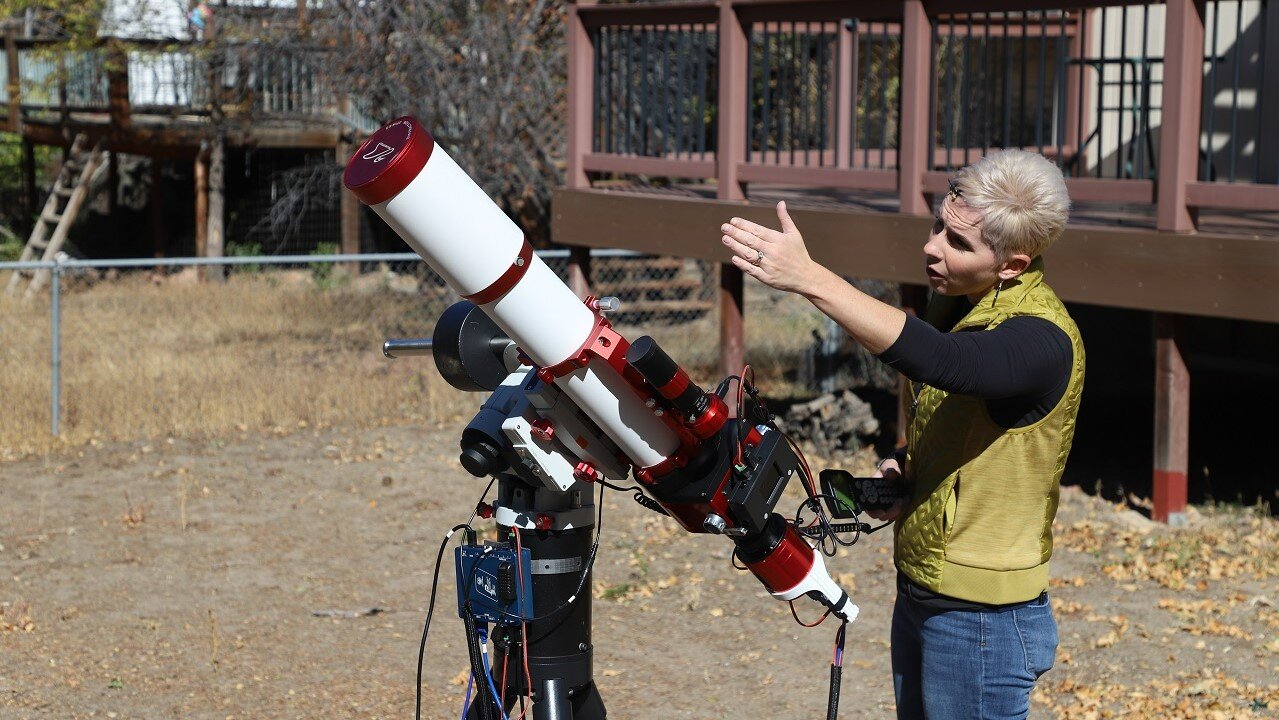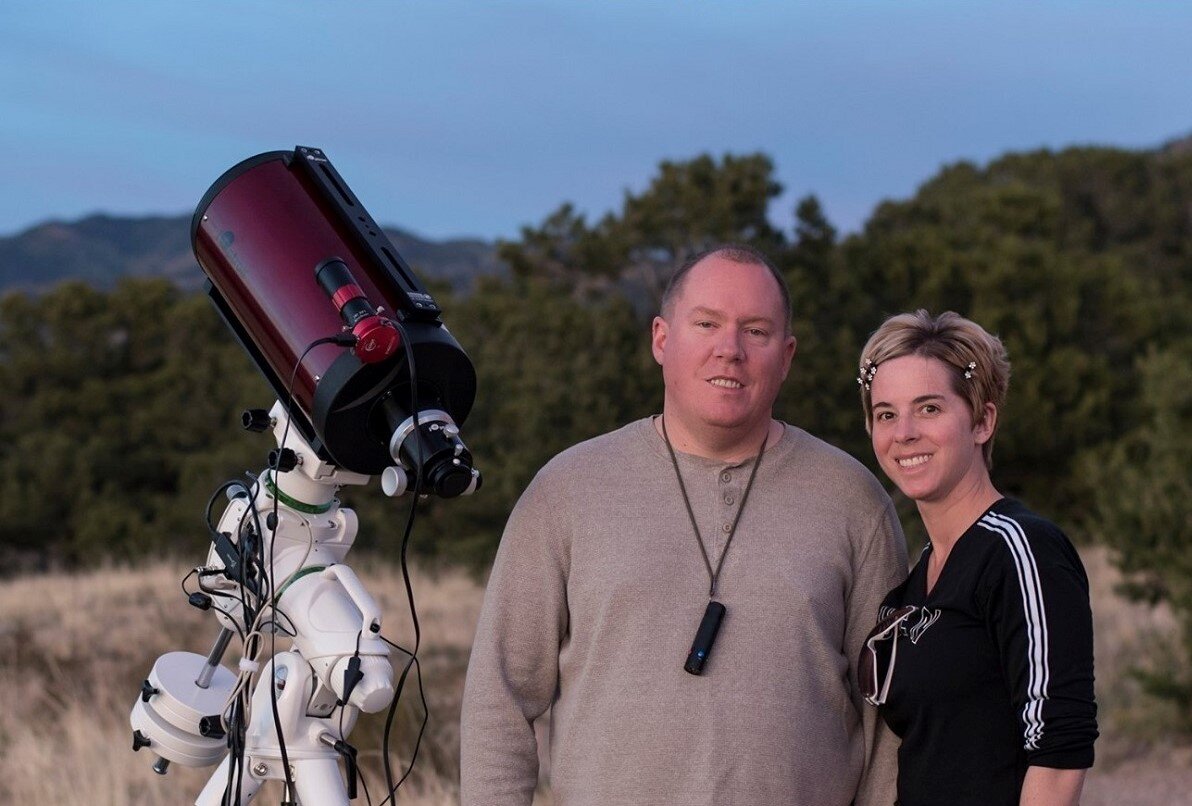Astrophotography brings out passion and a feeling of permanence for this Colorado Springs woman

COLORADO SPRINGS, Colo. — During the last few months, the world has been treated to the wonderous, colorful, star-filled and mesmerizing images from the NASA James Webb Space Telescope. The telescope is an orbiting infrared observatory meant to “extend the discoveries of the Hubble Space Telescope, with longer wavelength coverage and greatly improved sensitivity,” according to NASA’s description. While no other equipment can compete with the incredible images, not everyone relies on NASA to bring images of deep space.
On almost any given weekend night, with clear weather and a small moon, you could find Kara Marcus and her husband, James Miles, lugging equipment to their backyard. Nestled in a Colorado Springs neighborhood with street names like Carefree and Enchanted Circle, Marcus has found wonder and connection to the sky above her childhood home.
"It is a really good reminder of the bigger picture here," said Marcus. "I think a lot of people forget it and rely on NASA and the big scopes to show it to them. I think when you’ve got a friend or a neighbor in their backyard doing it, it’s a little more touching on the seriousness of it."
Storing telescopes, mounts, tripods and cameras inside their home, the couple takes out all the heavy equipment to their backyard to try and capture an element in our universe not seen by the naked eye. This method of photography is called astrophotography — it goes beyond landscape photography to use a combination of lenses, computers and telescopes to capture a moment in deep space.
"You can go out in the summer and set up a tripod and a camera and a wide angle lens and do a long exposure ... and get to see the stars in the Milky Way in the core and some beautiful details of the sky," Marcus explained. "I would say the biggest difference between that and deep space astrophotography is with deep space astrophotography, you're looking way closer in on a target."
To do that, Marcus and Miles must understand and keep track of what is happening in the sky above and when. Then given those parameters, they pick a target or two for the night, set up their equipment to get it polar aligned and then take long-exposure pictures for as long as possible — often lasting throughout the whole night.

The idea is to capture a series of long-exposure images, which invite more light into the lens, to gather as much visual data as possible. Marcus and Miles' equipment keeps them on the target throughout the night as the subject moves across the sky. The series of photos, which will be later layered on top of each other, add more detail to the image.
As one might imagine, this hobby isn’t best served by partial commitment.
"If you meet anybody in the astro[photography] community, they’re going to talk about the time that they spent on this," said Marcus with a smile.
On top of the time it takes to capture the images overnight, it takes about an hour to set up the equipment and a little bit less than that to take it down. While a lot of technology helps Marcus and Miles, they still must constantly check on the equipment throughout the night.
"We got up to the observatory property last Friday night at about 7:00 and we left the next morning at 7:30. So, we were there for 12 and a half hours," said Marcus.
Marcus and Miles often take the deep space photos from just their backyard, but they also have connected with a person who has an observatory near Florissant, about 11 miles west of Pikes Peak. There they have access to power to operate their equipment, and it's under a dark sky protected area and at high elevation. These conditions give Marcus and Miles an even better chance of capturing the beauty of the stars above.
"When I go to a dark sky and I look up and I see these things, these stars, these brighter stars, it’s like I reaffirm that they’re still there as am I. Me and the universe, we’re on the same terms," said Marcus.
When Marcus returns to inside her home, she then has the immense task of stacking the images and pulling out the beauty from them. A single image can look like a smattering of stars, but as she is able to put several images together, nebulas, galaxies and other targets really start to take shape.
"It’s my artistic outlet, you know, and I don’t get to do it every day," said Marcus. "If you’re a painter, you paint every day. This not so much. If the moon is big, if it’s cloudy … there’s so many obstacles, but it’s worth it."
Marcus considers her astrophotography journey truly beginning about seven years ago. She had been a photographer already, but a neck injury didn’t allow her to continue in that way. After experimenting with wide field astrophotography, which doesn’t typically involve a telescope, she mentioned an idea to Miles.
"I wanted to maybe see if I could shoot deeper, and then I kind of created a monster," Marcus explained laughing.
Sure enough, she and Miles fully committed to understanding and becoming astrophotographers. Miles took on more of the technical side of the hobby and Marcus focused on the artistic side while learning as much as she could. Together, this is something they've truly bonded over and share together.

"We don't have kids. This is kind of our baby," Marcus said.
They admit it is an expensive hobby — in both money and time. They've spent several thousand dollars for equipment over the years and countless amount of time experimenting while perfecting their craft. All of it didn’t sway Marcus’ passion for the hobby.
"I struggle with confidence and so my history, my track record, is to stop when something gets really hard," said Marcus. But this hobby was different.
"It’s like a personal vendetta with this because I want to show this field of photography who’s in control a little bit. I want to master it," she said.
Beyond the desire to conquer something and to gain confidence, Marcus said astrophotography saved her mind. Seven years ago, she was diagnosed with bipolar disorder, and on top of other treatments, this became a necessary therapy.
"I feel like I have a purpose and meaning when I do this, and that’s why I keep doing it," explained Marcus.
She finds every time she shoots, especially in a dark sky, she is grounded. Despite the vastness of the universe she captures, she finds permanence and importance and believes it could be the same for others.
"When you gaze up at the universe, you’re witnessing your connection to greatness,” said Marcus. “You start really realizing how important your place is here and how unique it is. What an amazing opportunity to not only just be here in this life, in this moment … and see this whole universe that’s a part of all of us and we’re all a part of it.”

To see more of Kara Marcus and James Miles' work, you can visit their Instagram page.
Amanda Horvath is the managing producer with Rocky Mountain PBS. You can reach her at amandahorvath@rmpbs.org.
Alexis Kikoen is the senior producer at Rocky Mountain PBS. You can reach her at alexiskikoen@rmpbs.org.